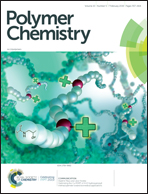π-Expanded diketopyrrolopyrroles as acceptor building blocks for the formation of novel donor–acceptor copolymers†
Abstract
The incorporation of rigid and planar, π-extended diketopyrrolopyrrole (EDPP) units into alternating donor–acceptor copolymers results in a variety of low band gap copolymers with thiophene-based EDPP (EDPPT) as acceptor blocks in combination with donor units as thiophene-2,5-diyl or cyclopentadithiophene-2,7-diyl (CPDT). These copolymers are characterized by a broad absorption range in the UV/Vis/NIR region and emission features extending into the Near Infrared (NIR) region. Furthermore, the EDPPT-based copolymers show small optical HOMO/LUMO gaps ranging from 1.65 to 1.81 eV. Replacing the terminal thiophene units of the EDPPT building blocks by fluorene moieties (EDPPF) results in the corresponding EDPPF building blocks for the formation of a second set of EDPPF-based copolymers. These copolymers display distinctly increased HOMO/LUMO energy gaps and well-resolved, mirror-symmetrical absorption and emission features with steep absorption edges and small Stokes shifts when compared to EDPPT copolymers, thus reflecting electronically only weakly interacting EDPPF structural units.



 Please wait while we load your content...
Please wait while we load your content...